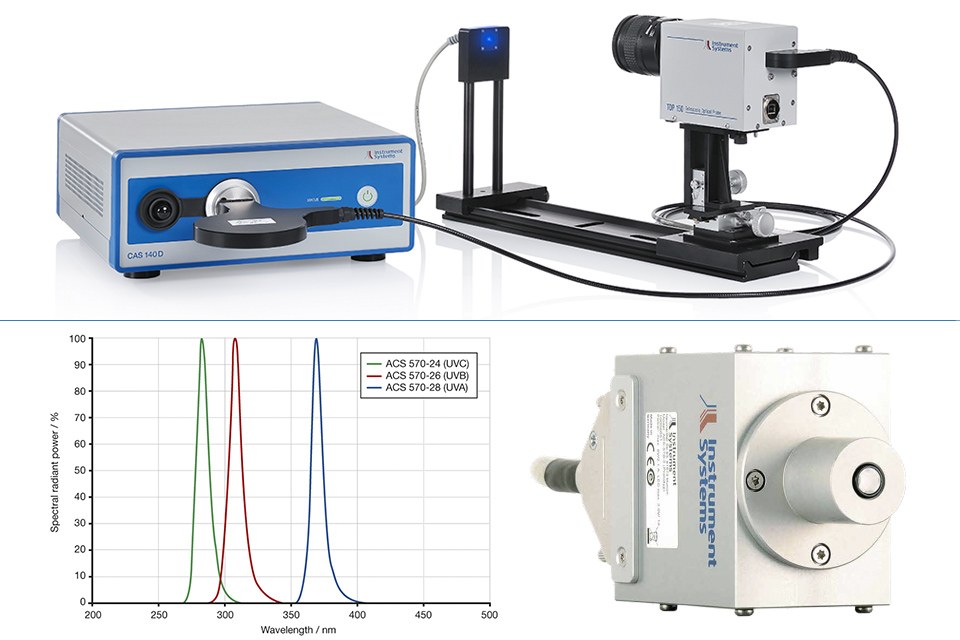Instrument Systems: New Products for the Postponed L+B
Instruments Systems has been prepared to feature two new respectively optimized solutions for two different tasks at Light + Building which is postponed to September 27th - October 2nd. Instrument Systems has modified its proven TOP 200 telescopic optical probe to satisfy the requirements of the new IEC TR 62778 technical report. Furthermore, Instrument Systems launches traceable calibration UV-LEDs with extremely low measurement uncertainty.
Reliable Measurement Solutions for BLH Testing to IEC TR 62778
The newly developed Technical Report IEC TR 62778 on photobiological safety prescribes practical methods for investigating the blue light hazard of LED light sources in general lighting. On this basis, Instrument Systems has modified its proven TOP 200 telescopic optical probe in satisfaction of the new measurement requirements while maintaining a high level of user comfort. In conjunction with a spectroradiometer, the adapted TOP 150-BLH reliably determines the blue light hazard by an explicitly defined weighting function in the SpecWin Pro analysis software. Compared to previous measurement solutions, the TOP 150-BLH is a fast and attractively priced alternative.
The rapidly increasing significance of modern solid-state lighting technology in our daily environment poses important safety aspects with regard to photobiological safety and blue light hazard. The current international standard IEC 62471 contains the appropriate guidelines for the evaluation of lamps and lamp systems. Because it places extremely strict requirements on measuring equipment and procedures, supplementary practical evaluation methods have been introduced with Technical Report IEC TR 62778.
On this basis, Instrument Systems has developed a fast and practical measuring system for the evaluation of LEDs in excess of 360 nm. The new TOP 150-BLH telescopic optical probe is based on the proven TOP 200 telescopic optical probe, although it has only one aperture with a diameter of 7 mm. The aperture is positioned at the same height as the objective lens and corresponds to the reference level. A measuring spot over 2.2 mm is set via an internal aperture for test objects at a distance of 200 mm. This can be easily positioned by means of an internal alignment camera.
A direct spectral radiance measurement can be made in conjunction with a calibrated CAS 140 D spectroradiometer and the accompanying SpecWin Pro analysis software. For effective evaluation of the blue light hazard the IEC 62471 standard prescribes a weighting factor by which the spectral measurement data must be multiplied. This function covers the wavelength range between 300 und 700 nm and has a maximum of 435 to 440 nm. In this range, blue light can cause photochemical damage to the retina. Independently of the radiation density LB and the calculated maximum exposure time tmax measured with the blue light hazard function, the analysis software classifies the light sources according to the four risk groups specified by the standard. Due to the simple measurement set-up, rapid and long-term stable measurements are also possible in production applications.
Additional information is available at https://www.instrumentsystems.com/en/systems/blue-light-hazard-measurement/
Precise Radiation Measurement in the UV Range
Calibration UV-LEDs of the Instrument Systems ACS series are extremely stable UV sources on LED basis that are traceable to radiant flux. They exhibit an extremely low measurement uncertainty (k=2) of only 4.5% (UVC), 3.5% (UVB) and 2% (UVA) and are available for typical peak wavelengths 280 nm (ACS-570-24), 305 nm (ACS570-26), and 365 nm (ACS-570-28). Calibration UV-LEDs are used for absolute calibration and monitoring of UV measuring equipment.
Instrument Systems was the first company in the world to develop calibration UV-LEDs that can be traceably calibrated to radiant flux. The calibration UV-LEDs of the ACS series are available for the typically peak wavelengths of 280 nm (UVC), 305 nm (UVB) and 365 nm (UVA). The proven ACS series on LED basis now covers the complete visible and infrared to deep into the ultraviolet range. The traceability of the radiant flux is achieved due to the highly precise calibration of the spectrometer optical probes to the irradiance and integrative measurement with the goniophotometer. The extremely low measurement uncertainty (k=2) of only 4.5% (UVC), 3.5% (UVB) and 2% (UVA) is comparatively low, as in the metrologically unproblematic visible range. Calibration UV-LEDs can be used for monitoring and absolute calibration of the special UV measuring equipment such as integrating spheres of the ISP-UV series.
Additional information is available at https://www.instrumentsystems.com/en/products/calibration-standardsservices/calibration-leds/
About Instrument Systems GmbH:
#Instrument Systems GmbH, founded in Munich in 1986, develops, manufactures and markets all-in-one solutions for light measurement applications. Its core products are array spectrometers and imaging colorimeters. The company's main fields of activity are LED/SSL and display metrology, spectral radiometry and photometry, where today Instrument Systems is one of the world's leading manufacturers. The Optronik line of products for the automotive industry and traffic technology is developed and marketed at its Berlin facility. Instrument Systems has been a wholly-owned subsidiary of the Konica MinoIta Group since 2012. - www.instrumentsystems.com/en/

